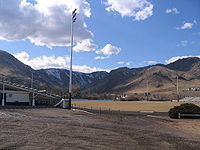Campbell Field (Colorado)
| Former names | Athletic Park (1893–1922), Brooks Field (1922–2010) |
|---|---|
| Location | Golden, Colorado |
| Coordinates | 39°45′11″N 105°13′39″W / 39.75306°N 105.22750°WCoordinates: 39°45′11″N 105°13′39″W / 39.75306°N 105.22750°W |
| Owner | Colorado School of Mines |
| Operator | Colorado School of Mines |
| Capacity | 4000 |
| Surface | Turf |
| Construction | |
| Broke ground | February 1893 |
| Opened | May 20, 1893 |
| Architect | William "Cement Bill" Williams (1922–24 grandstands) |
| Tenants | |
|
Colorado School of Mines Orediggers (1893–present) (1893–1936: Baseball, Soccer) |
|
Campbell Field, officially Marv Kay Stadium at Harry D. Campbell Field, is an American college football stadium located in Golden, Colorado. The stadium serves as the home field of the Colorado Mines Orediggers football team representing the Colorado School of Mines. Campbell Field is one of the oldest football fields in existence, the oldest west of the Mississippi River and the oldest in NCAA Division II. Originally it was a dirt surface all-purpose athletic field in exactly its current configuration, built within a clay pit, a fitting mined-out home for the Orediggers. Its first athletic contest, held on May 20, 1893, was the first annual Colorado Inter-Collegiate Athletic Association Field Day, featuring many athletic contests between the University of Colorado, Colorado A&M, Colorado School of Mines, and the University of Denver, in which Mines claimed the most medals. Its first football game took place on October 7, 1893, a 6-0 Mines victory over the University of Denver. It has been home to the football Orediggers through all but the first five seasons of their existence (their previous home were the now-destroyed grounds at the southeast corner of 19th and Illinois streets in Golden), and has been renovated several times throughout its existence. The field was originally called Athletic Park, renamed Brooks Field after Mines trustee and benefactor Ralph D. Brooks in 1922, and renamed Campbell Field after 1939 undefeated team member and benefactor Harry D. Campbell in 2010. Campbell Field is the oldest football field in the west, the oldest in NCAA Division II football and the 5th oldest college football field in the nation.
Historic photographs show Brooks Field as a dirt surface, without grandstands and surrounded by a board fence. Despite such conditions it is known to have hosted crowds of spectators, who could have used nearby slopes to view games from. Later early wooden grandstands were added to the park. In 1922 and 1924 the current grandstands were built by noted local builder William "Cement Bill" Williams. This featured wooden bench seats upon a steel superstructure, with home and visiting locker rooms, public restrooms and refreshment stand beneath. In 1922 the dirt surface was converted to natural grass, part of which was scraped back to dirt surface for a baseball diamond during season each year. Originally home also to the CSM baseball team, it became a primarily football facility in 1937 after baseball was moved to Darden Field just to the west. During the 1930s a Federal Emergency Relief Administration project scooped out the slopes at the west side of Brooks Field to make room to construct a track around the surface, and it has hosted track and field events since. Around the 1980s the grandstands were renovated to cover most wooden benches with metal surfaces and create a central concourse, along with steps down to the field level. In 2010, the field was converted to its third surface, synthetic turf. Plans are underway to replace the 90-year-old grandstands and update the historic field to a state-of-the-art Division II athletic facility, expanding its capacity to 5,000, to be rechristened Marv Kay Stadium at Campbell Field.
...
Wikipedia

